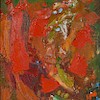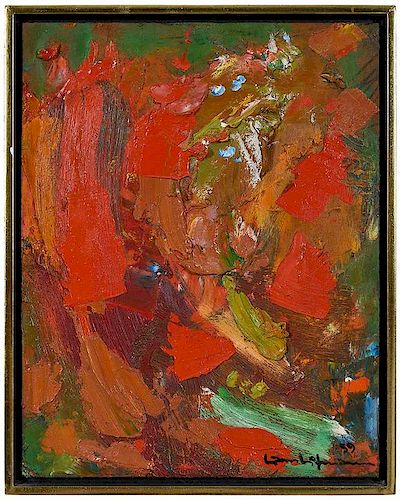(New York/Massachusetts/Germany, 1880-1966)Fall Foliage (H.H. 976-1959, V. P1151), "Hans Hoffmann 59" and signed and inscribed verso, oil on panel, 14-1/8 x 11-1/8 in.; parcel gilt wood frame, 15-1/4 x 12-1/8 in.Note:ÿ"Hans Hofmann (1880?1966) is one of the most important figures of postwar American art. Celebrated for his exuberant, color-filled canvases, and renowned as an influential teacher for generations of artists?first in his native Germany, then in New York and Provincetown?Hofmann played a pivotal role in the development of Abstract Expressionism.Between 1900 and 1930, Hofmann?s early studies, decades of painting, and schools of art took him to Munich, to Paris, then back to Munich. By 1933, and for the next four decades, he lived in New York and in Provincetown. Hofmann?s evolution from foremost modern art teacher to pivotal modern artist brought him into contact with many of the foremost artists, critics, and dealers of the twentieth century: Henri Matisse, Pablo Picasso, Georges Braque, Wassily Kandinsky, Sonia and Robert Delaunay, Betty Parsons, Peggy Guggenheim, Lee Krasner, Jackson Pollock, and many others. His successful career was shepherded by the postwar modern art dealer Sam Kootz, secured by the art historian and critic Clement Greenberg, and anchored by the professional and personal support of his first wife, Maria ?Miz? Wolfegg (1885?1963).ÿAlready 64 by the time of his first solo exhibition at Art of This Century in New York in 1944, Hofmann balanced the demands of teaching and painting until he closed his school in 1956. Doing so enabled him to renew focus on his own painting during the heyday of Abstract Expressionism, and for the next twenty years, Hofmann?s voluminous output?powerfully influenced by Matisse?s use of color and Cubism?s displacement of form?developed into an artistic approach and theory he called ?push and pull,? which he described as interdependent relationships between form, color, and space. From his early landscapes of the 1930s, to his ?slab? paintings of the late 1950s, and his abstract works at the end of his career upon his death in 1966, Hofmann continued to create boldly experimental color combinations and formal contrasts that transcended genre and style."For thirty years, 1967-1997, Hans Hofmann exhibited at Andre EmmerichÿGallery in New York.http://www.hanshofmann.orgLiterature:ÿVilliger, Suzi, and Hans Hofmann.ÿHans Hofmann: Catalogue Raisonne of Paintings. 2014, P1151, pg. 196, Vol.IIIÿThis lot is accompanied by a facsimile of the catalogue raisonne page featuring the painting. Provenance: Estate of the Artist; Andre Emmerich Gallery, Inc., New York, 1982; Private Collection, North Carolina
Condition
some crackle with separation at highest impasto peak



























